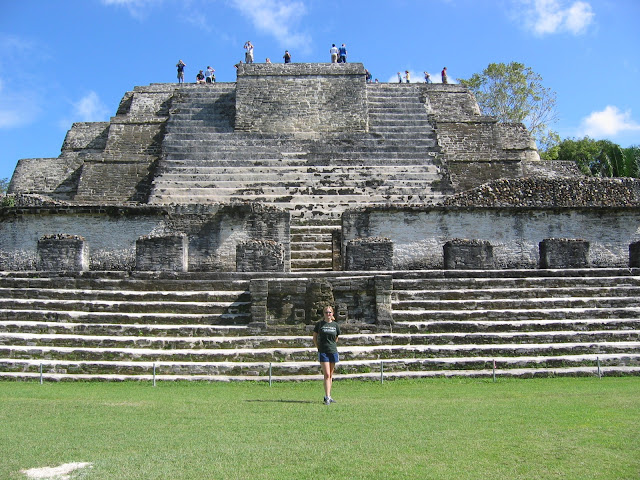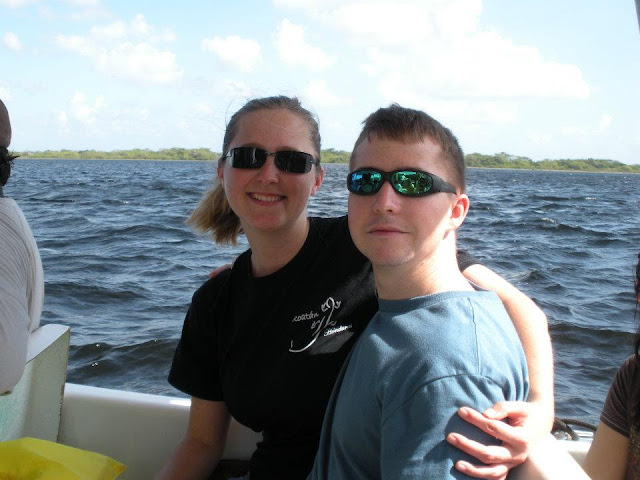Tulum, Altun Ha, and Lamanai
It's safe to say the Indiana Jones movie trilogy (I do not count the last one) left its mark on me. While I never planned (and still don't) on becoming an Archeologist, I still have a deep seed fascination of ancient ruins. Being from the US, petra in Jordan and the pyramids in Egypt were a bit far away (and a lot of money). So, I set my sights on ancient ruins a little closer to home and a lot easier to get to. While I still plan on getting to the pyramids and petra (I'll be going this summer), the ancient Mayan ruins of Central America gave me that first taste of archeology I had been craving. In this post, I highlight the three Mayan ruins I've visited in Central America.
Tulum, Mexico
 |
| The ancient Mayans viewed caves as important portals to the underworld, and they were as important in Mayan worship as their buildings and temples. |
The Tulum Mayan ruins are located on the Yucatan Peninsula of Mexico. We visited Tulum from Cozumel via a ferry (~1 hour) and then a bus (~1.5 hours). Tulum is unique among Mayan ruins in that the complex is located on a cliff over looking the ocean. Tulum is thought to have been an important port city in the Mayan world, being particularly important in the obsidian trade. I saw many visitors swimming and snorkeling in the water below the main temple, although I did not have enough time to go in myself. We came with a tour group (priced about $100), but for the most part wandered around the ruins on our own for a little more than an hour.
 |
| The greater complex of Tulum, Mexico. |
The Tulum ruins are relatively well preserved, with Mayan painted art visible on many of the buildings. It is more rare to see painted art on Mayan ruins than art carved into the rock which can better withstand weathering. Tulum also offers monuments that visitors can look into, with walls, pillars, and ceilings intact, something I have not encountered at other Mayan sites. At most ruins visitors can enter buildings missing ceilings, or they can only climb on top of the monuments. The good preservation of the monuments and buildings at Tulum are probably a result of the youthfulness of the site. Tulum is thought to have been founded in the 6th century AD and remanned occupied until after Columbus discovered the new world.
However, despite the well-preserved art and seaside views, most of the buildings at Tulum are rather small compared to other ruins. The largest monument at Tulum, which can be seen in the photo above reaches a height of just 25ft. A small (less than 6 ft) wall encloses the ruins on all sides, except for the ocean side (Tulum meaning wall or fence in Mayan). Much of the wall has been rebuilt recently by locals. It is easy to parse out ancient sections of the wall from restored sections. The Mayans used virtually no mortar to hold the stone bricks of their structures together, whereas newer sections of the wall show rounded stones hewn together with an abundance of cement.
 |
| One of the large iguanas at the Tulum Mayan ruins. |
In addition to the ruins at Tulum, there was a plethora of extremely large iguanas. These reptiles reached lengths of up to 3 feet. Near the end of our time at Tulum, I found myself more interested in these critters scurrying about than the ruins themselves.
Altun Ha, Belize
Altun Ha was the first set of Mayan ruins I visited. It is a medium-sized collection of monuments in Belize about a 45 minute bus ride from Belize City. Our tour to the ruins from Belize City cost around $45. I've recommended the Altun Ha ruins to many people visiting Belize, due to the low cost and short travel time to the ruins. The well-manicured grounds also make it easier for less able-bodied persons to keep up with the tour group.
 |
| Walking up the steps on the side of the main monument. The stairs were installed to make it easier for visitors to ascend to the top. |
Altun Ha has seen a lot of restoration via uncovering of buried monuments and manicuring of courtyards. Due to maintenance of the landscaping in addition to the monuments, it was especially easy for me to visualize what the city once looked like.
 |
| The view from the top of the tallest monument. The courtyards and landscaping are well kept at Altun Ha. |
As part of our tour, we were allowed to climb the largest monument at Altun Ha, which reaches a height of 54 ft. Stairs have been added to the side of the monument to make the ascent easier and protect the face of the monument from erosion. However, the top of the monument lacks any barricades to prevent visitors from falling over the edge. The large monument was found to contain empty rooms (which unfortunately we did not get to see) that were probably the resting place of local priests. A large jade pendant of the Mayan sun god was found in one of these empty rooms, which gives Altun Ha notoriety in Mayan Archeology.
 |
| Standing in front of the largest monument at Altun Ha, which reaches a height of 54ft. Visitors can reach the top by ascending a staircase built on the side of the monument. Stakes holding ropes prevent them from climbing up the face. |
The name Altun Ha comes from the Mayan for "Rockstone Water". This name was given to the ruins due to a nearby sinkhole (featured in our tour) that provided water to the ancient city's estimated 10,000 residents. Altun Ha's origins date to 250 BC, and is thought to have been a relatively peaceful settlement.
Lamanai, Belize
As with many of these types of posts, I have saved the best for last. Lamanai, Mayan for submerged crocodile, is my favorite of the Mayan ruins I have visited for many reasons. Just getting to Lamanai was an adventure. We took a tour to Lamanai out of Belize City for about $100. The tour began with an hour bus ride, followed by an hour boat ride up a river, during which time we saw a variety of birds, crocodiles, and monkeys. I felt I got my money's worth by the time I disembarked from the boat.
 |
| Enjoying the hour long boat ride to Lamanai. |
Since Lamanai requires a boat ride to get to, it was the least crowded of all the Mayan sites I've visited. It is also the oldest (dating back to 16th century BC, almost it 1400 years older than Altun Ha and over 2000 years older than Tulum) and the largest (the largest monument standing over 120 ft high). Lamanai is the most Indiana Joneseqs of the sites. Giant trees laden with vines and monkeys were interwoven with the monuments, preventing a clear view of much of the site through the trees. I felt as if with every step some new magnificent ruin came into view.
 |
| One of the giant faces carved into the Mask Temple at Lamanai. |
Another unique trait of Lamania is that visitors are allowed to climb up the face of the monuments, something forbidden at Tulum and Altun Ha. We were even allowed to climb up the face of the largest monument. I am afraid of heights, and the stairs were as steep as a step ladder. They were easy to climb up, but more difficult to climb back down.
 |
| Carefully making my way down the 120ft tall monument aptly named the High Temple at Lamanai. |
Lamanai is the least excavated of the there sites, with much of the ruins still lost to the jungle. I would not hesitate to revisit Lamanai again given the chance, but I will be patient and wait until more of this glorious city is excavated.
 |
| Atop one of the many large monuments at Lamanai. |










No comments:
Post a Comment